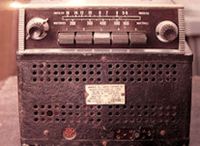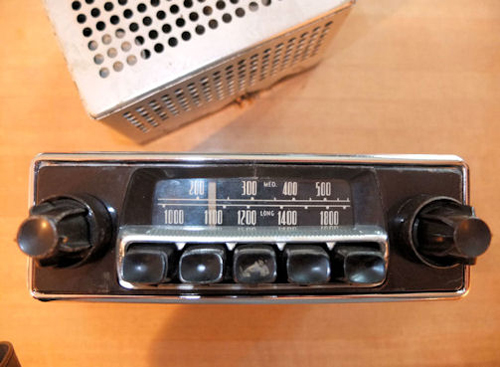Radiomobile

 My hands shook as I excitedly opened the package. It had taken eight days to come from Great Britain in spite of being sent by expedited means. I wondered if the contents would be as nice as the pictures in the eBay listing. Would it function or would I end up the proud owner of a conversation piece? To my delight the item looked pretty good and after ten minutes of set up, the dial light on my used Radiomobile 200x began to glow!
My hands shook as I excitedly opened the package. It had taken eight days to come from Great Britain in spite of being sent by expedited means. I wondered if the contents would be as nice as the pictures in the eBay listing. Would it function or would I end up the proud owner of a conversation piece? To my delight the item looked pretty good and after ten minutes of set up, the dial light on my used Radiomobile 200x began to glow!
While the unit warmed up I readied the NOS Radiomobile speaker I had acquired two years earlier. The first wire yielded silence from the paper cone but the second wire emitted a crack upon connecting. I plugged in a cheap test antenna and the radio responded with a hum and a whistle. Yes, Dr. Marconi we have a signal! As I turned the dial, the unit warmed and I could hear words and the notes of music between the blasts of static and whistles of frequency modulation. It’s alive! Thus began my adventure. Join me now, as we go where no other writer has gone before, Radiomobiles for MGAs.

Clausager and Vitrikas both make mention of Radiomobile being the standard factory offering for our MGAs, yet little information is available on what these radios looked like or even how they installed and functioned. In 1955 Radiomobile produced different models in the 200 Series of which the 200X, 212X, and the 220X were all push button units. This is according to information supplied by Smiths in their service manuals from December of 1955. The 200 Series were “two box” units filled with glowing tubes, buzzing transformers, and condensers. The dash unit containing the tuning controls and the second box contained the amplifier. The 200X unit (shown in the picture above with the amplifier) was a dual wave band design with tuning on long and medium wavebands, while the 202X was a medium waveband unit only. I have never yet seen a picture of the face of the 202 unit. On the five push button dual wave designs the far right hand button was used for selecting the long waveband mode along with the chosen station. The other buttons selected set medium wave stations.
The 200 R Series models were also push button units, but had a slightly different fascia treatment with chrome on the knobs and some slight changes to the internal circuitry. I have never seen one of these or even a picture of one. What little I know about these units tells me that they were probably intended for luxury saloons of the Daimler and Rolls ilk.
Well, by now you are probably wondering, “What has all of this got to do with anything?” Well, they are original to the MGA and Clausager or a concours judge would like that. Is this just useless trivia? You may well be right, but there is some usefulness to these radios as the medium waveband is equivalent to the AM band used here in North America. Now, now, I just heard someone yell, “Hogwash!” How can I make such a statement, when the numbers on the radio face run from 1000 to 1800?
Well, take a look at the picture of the 4202 model below. This is a single waveband model with dual scales; the upper one being for the AM waveband marked in frequencies and the lower for the same band (dubbed medium wave in Great Britain) marked in wavelength.
The 400 Series radios, like the one above, were all “two box” units like the 200, but were newer models that replaced 200s in 1958 and 1959. I don’t know much about these, suffice to say. They were upgrades to the 200s, but still were all tube designs and were replaced by the 500 Series, which incorporated that new invention known as the transistor. But that is a discussion for another time.
I know this all seems like nonsense. After all, who would want to use one of these old radios anyway? There is no FM band and the speaker is limited to one with not much fidelity. I thought that too, until I set up the radio one summer night in my back yard in Pulaski, WI. It was the middle of June and the moon was just coming up. Spinning the dial captured that evening’s Milwaukee Brewers game and I was transported to my youth (it was the Braves then). The warm crack of the bat and the roar of the crowd reminded me of simpler times when I was still dreaming of driving a car, girls were annoying (some of the time), and I couldn’t wait to grow up. With that my thought turned to wondering if I could “pull in” WLS in Chicago. Yup! That worked too.
The 200x will become part of my early model 1956 MGA restoration. I am the proud owner of an OEW roadster with the big lettered instruments. Most of the components are restored, but the car still remains in pieces. So my adventure continues as my interest in originality increases. There is a lot more that could be said about Radiomobiles for MGAs and other radios, like Blaupunkt, Motorola, and Becker. For that matter, there is even more to be said about Lucas components, Lockheed brakes, “leather cloth” claddings, rubberized horsehair, and fabric hoses to mention a few. Let me know if you enjoyed this trip back in time to how it was and I will happily pursue other elements of originality for, if nothing else–curiosity. From the Right Lane….


Comment by: Radha Singh
Interesting. Just located a guy that can do the AM/FM conversion without tearing out the guts of the radio. Can’t wait to get it done.
Comment by: John Melton
I know it would be a sacrilege to some but I had my Radiomobile converted to a modern AM-FM. It’s much more enjoyable and looks original.
Comment by: Radha Singh
This is GREAT! Just found my 3rd Radiomobile, one for each of my A’s. 2 50T’s and 20X for my ’55. Love to see more on period accessories. Thanks.
Comment by: Graeme E. Ott
Brings back memories of installing my radio and speaker in my new 1959 MG. The cost new then was 35.00 and I still have the original paper work and warranty.Thankfully I never had to use use the warranty.After restoration in 2000 I decided to put the original red blanking plate back into the dash.
Comment by: Graeme E. Ott
Brings back memories of installing my radio and speaker in my new 1959 MG. The cost new then was 35.00 and I still have the original paper work and warranty.Thankfully I never had to use use the warranty.